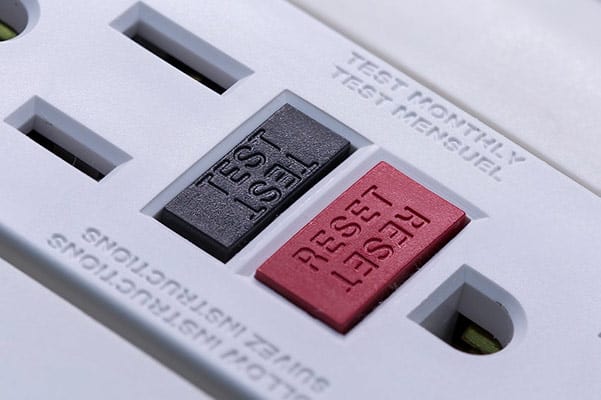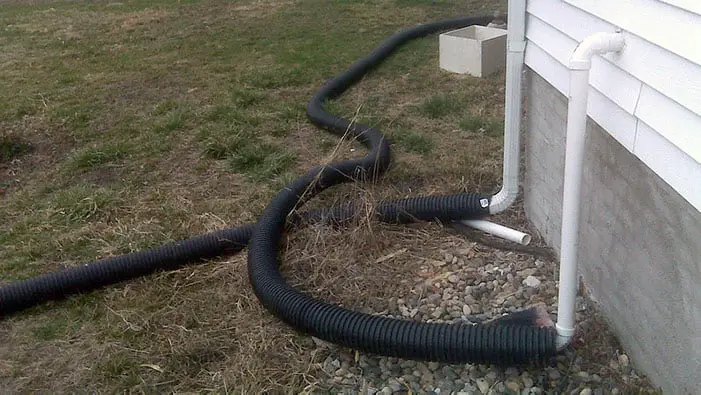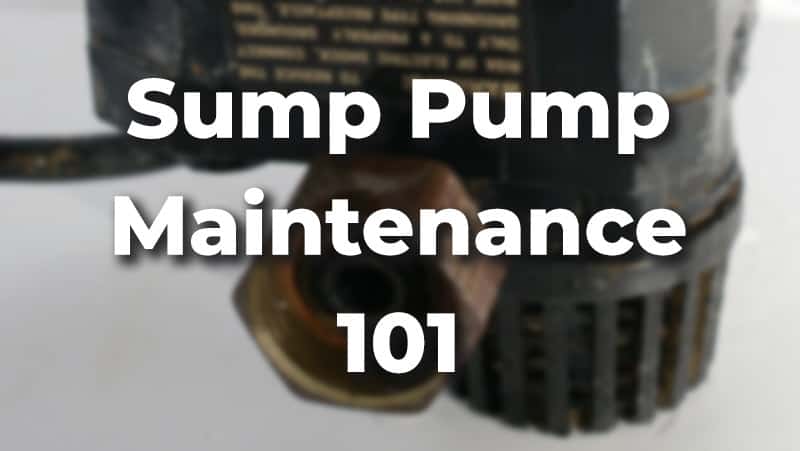If you live in a house that has a basement, chances are great you have a sump pump installed. Although typically you don’t need it all year long, it really comes in handy when groundwater begins to rise due to heavy rain, snowmelt, or flood.
While proper installation is an important first step, sump pump maintenance is essential if you want your device to work reliably in the coming years. Fortunately, it’s a task that’s neither complicated nor time-consuming and often you can DIY.
Looking after your device is well worth the effort, I know from experience. Having a sump pump that’s not maintained will give you a false sense of safety and there’s a good chance that it will let you down when you need it most.
Why Sump Pump Maintenance Is Important
To be honest, your sump pump will probably run without any major issues for months (or even years) after installation, even if you completely ignore maintenance. In fact, a sump pump often sits for several months before the owner really needs it.
However, if you want to prevent your basement from flooding and water damage in the long run, you have to look after the whole system, including the discharge pipe, sump pit, and drainage channels.
If any of these fail, the whole system will stop working properly. For instance, if your sump pump runs flawlessly but the discharge pipe is clogged, water will flow back into the pit and the pump will become overwhelmed.
With proper and regular maintenance you can avoid many failures and other unpleasant surprises that could not only cause a lot of annoyance but also severe property damage. This way you can also prevent drain flies and other pests from appearing or coming back to your home.
While the following recommended maintenance tasks are applicable in most cases, make sure you also read the instructions of the manufacturer as some devices may require special care.
FYI – If you suspect that your device doesn’t work properly or simply want to know more about the possible causes of sump pump failure and troubleshooting, check out our helpful guide here.
When Should You Perform Maintenance on Your Sump Pump?
Most experts would agree that certain maintenance tasks (such as testing the outlet) should be performed monthly or quarterly, while others annually to prevent failures and get the most out of your sump pump.
What time of the year is the best for annual maintenance?
While regularly maintaining your sump pump is much more important than timing, you want to make sure your device works perfectly before upcoming floods, snowmelt, and groundwater rise.
In this regard, there is no best time to do the annual maintenance of your pump as the amount of precipitation and groundwater level depends on the climate in your region. For instance, in California, there is usually much more precipitation during the winter months, while in Colorado the exact opposite is true (1, 2).
Safety first: Having an electrical appliance that sits in water always highly increases the chance of an electric shock (it’s especially true in the case of submersible pumps). Therefore, before you start working on your sump pump always make sure you unplug it and disconnect it completely from the power source.
Monthly to Quarterly Sump Pump Maintenance
1. Test Your Sump Pump
In order to make sure your sump pump is working properly, you should routinely test it. Just pour a few gallons of water into the sump pit and check whether the float switch elevates and the device starts pumping the water out.
Also, make sure the pump turns off once the water is eliminated.
You should perform this test at least quarterly.
2. Test the Outlet

In many countries (including the US) sump pumps are required to be placed on a GFCI (ground-fault circuit-interrupter) protected circuit. In most cases, GFCI outlets can prevent electrical shock and save your life, so they’re extremely important regarding safety.
However, certain types of GFCIs are prone to shut off for no real reason. If that happens, your sump pump goes off because of the power outage and when you really need it, it won’t work.
Thus, it’s important to check regularly if the outlet the sump pump is plugged into is live. Also, make sure the power cord is not torn or damaged in any other way.
Another thing you should do is check if the safety feature of your GFCI outlet works properly. In most cases, you can easily do that by pressing the test button on the outlet that should turn the power off. Experts recommend performing this test once a month (3).
3. Clean the Inlet Screen
If the inlet of your sump pump is clogged, your device either stops working or runs inefficiently. Before cleaning the inlet screen, make sure you first unplug the sump pump.
In most cases, you have to eliminate standing water from the basin to gain access to the inlet screen. As a next step, inspect the screen and clean it (you can use a wire brush). Make sure there’s nothing left that’s blocking it (debris, silt, gravel, etc.).
Usually, it’s enough to clean the pump inlet screen quarterly unless debris and dirt tend to accumulate rapidly in your sump pit.
4. Test the Backup Pump (If Applicable)
Battery-powered backup pumps are highly recommended as they can prevent your basement from flooding if your primary pump fails (for instance, due to a power outage). If you have one, make sure you check if it works properly at least once every 3 months. If needed, replace the battery.
Annual Sump Pump Maintenance
Most annual maintenance tasks can be done properly by an experienced homeowner, however, if you are doing it for the first time, often it’s a good idea to let the job be done by a plumbing expert.
If you are more of a visual type of person, here is a video that demonstrates the most important steps:

And now let’s see the maintenance checklist.
1. Clean Your Sump Pump
At least once a year you should remove your sump pump from the pit to check its condition and clean any dirt buildup. Before you do that make sure you disconnect your device from the power source and the discharge pipe as well.
- Wipe the exterior part of the device using clean water and a cloth. Don’t miss the float.
- Check the inlet screen and clean it with a brush if it’s clogged.
- Remove and inspect the check valve to make sure it’s working properly.
Bearings may require lubrication: if you’re in doubt, I recommend you check the manufacturer’s instructions on whether lubrication is needed in the case of the model you own.
Safety Tip: Use safety goggles and work gloves while inspecting and cleaning the device.
2. Remove Debris and Sludge From the Sump Pit
As a second step (while the pump is removed), inspect the sump pit and remove any debris, gravel, sand, and sludge from it (again: wear goggles and protective gloves).
If standing water is present, make sure you remove it first. If there’s not enough light in the room, use a flashlight.
Keeping the sump pit clean and tidy will not only reduce the chance of a sump pump failure but will also help you prevent pests, such as drain flies from appearing in your basement and house. If you’re already facing an infestation, check out this article to get rid of them as quickly as possible.
Note: If you drain water from your washing machine into the pit, sludge can build up pretty quickly. So if that is the case, you might need to clean the pit more frequently.
3. Check the Discharge Pipe

The discharge pipe runs from the pit to the outside of the house. If it gets clogged (completely or partially), the sump pump either stops working or becomes overworked. This will likely lead to a failure sooner or later.
Therefore, it’s recommended to check regularly if yours is fully functional. Make sure you also look for small particles that don’t clog the pipe but narrow its diameter, thus reducing the water flow.
Discharge pipes can be clogged by all kinds of things, such as rocks, dirt, rodents, or other small animals. To prevent that situation you can use a screened vent cap or a grate to protect the opening of the pipe.
During the winter months, your discharge pipe may freeze, especially if it isn’t buried below the frost line in the ground. If the part that runs above the ground is frozen, using heat tape or adding insulation can provide a solution.
4. Check and Clean the Drainage System
The drainage system collects and channels water into the sump pit. If it becomes clogged or dysfunctional in any other way, water will accumulate in your basement regardless of whether the sump pump works properly or not.
How to Deal With Sump Pump Odors?
Most people usually won’t notice unpleasant odors until they start the maintenance process (especially if the pit is covered with a sealed lid). So what to do if your sump pump smells like rotten eggs?
Possible Causes of Sump Pump Odor
- Dry sump pit. If your sump pit is connected to a sewer drain, it should always contain at least a small amount of water in the drain trap in order to prevent unpleasant odors from penetrating your home.
- Stagnant water in the pit. If the pump doesn’t run for a longer period of time (during a dry season, for instance), mildew, bacteria, and other germs begin to multiply in the stagnant water and make the pit smell stinky.
- Sewage leaking. Sometimes sewage, due to a ruptured household sewer line, seeps into the groundwater that enters the sump pit. In this case, the source of the odor is the leaking sewage and not the sump pit water. If you suspect that your pump smells because of a broken sewer line, you should ask for professional help.
- You drain washing machine water into the sump pit. Wash wastewater speeds up the sludge buildup in the pit that requires more frequent cleaning.

How to Get Rid Of Bad Odors Coming From the Sump Pit?
In most cases, regular maintenance will prevent strong odors, however, sometimes you will need to take some extra steps to completely get rid of them.
So, how do you eliminate sump pump odor? Well, it mainly depends on the cause of the unpleasant smell.
If the root of the problem is stagnant water, you can fix the odor issue by cleaning the walls of the sump pit (you can use a garden hose) and then sanitizing the pit with some diluted bleach (4).
If your sump pump smells like rotten eggs (sulfur dioxide) or poops and your pit hasn’t dried out, there’s a chance that the reason behind the bad smell is a ruptured sewer line and sewage leaking into the pit. In this case, you should call an expert as soon as you can to help you identify the exact location of the possible rupture.
Another reason for the rotten egg smell is that there’s no water in your pit. If you find an empty sump pit that’s connected to a sewer drain, you should pour some water into it so that the sewer gas won’t enter the house. You can also use some diluted bleach to kill germs.
Related Questions
Should you call a plumbing expert to maintain your sump pump?
It depends on your skills. Most maintenance tasks can be done by an experienced homeowner, however, if you are a newbie, you are better off having the annual maintenance done by a professional instead of DIY (remember: in the case of a submersible pump there’s a risk of electrocution if you mess things up).
How much does sump pump maintenance cost?
According to HomeAdvisor, if you hire a contractor, yearly maintenance usually costs $150-$250 which includes cleaning the pump and the pit, checking the discharge lines, and testing the system.
Photos: Wikimedia, Flickr (JP Goguen, Scott O’Dell, Carbon Arc)











